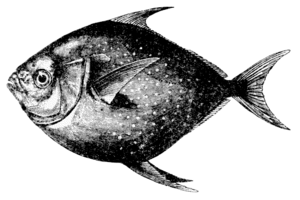Acanthomorpha
| Acanthomorpha | ||||||||||||
|---|---|---|---|---|---|---|---|---|---|---|---|---|

God salmon ( Lampris guttatus ) |
||||||||||||
| Systematics | ||||||||||||
|
||||||||||||
| Scientific name | ||||||||||||
| Acanthomorpha | ||||||||||||
| Rosen , 1973 |
The Acanthomorpha (or Acanthomorphata in EO Wiley & G. David Johnson (2010) and R. Betancur-R. Et al. (2017)) are a group of the real bony fish (Teleostei), of which about 18,100 fish species are 60% of the recent bony fish species, around a third of all vertebrate species and over 300 fish families, belong.
The Acanthomorpha show an astonishing diversity of body shapes, skeletal and soft tissue anatomy, size, habitat, physiology and behavior. They are at home in most aquatic habitats, in the deep sea as well as in mountain streams, in springs in the middle of deserts and in cave waters. They include the longest ( Regalecus glesne with up to 8 meters), the heaviest ( sunfish with 2.3 tons) and some of the smallest ( Schindleria with 7.9 mm) bony fish.
features
The synapomorphies of the Acanthomorpha include real, unsegmented dorsal and anal fin spines (absent in many cod-like, most glossy fish and many " perch-like (Perciformes)") and a rostral cartilage, which ensures that the premaxillary can be extended . In addition, they differ from more native fish groups by the anatomy of the ligaments in their jaw skeleton and vertebrae, as well as by features of their pelvis and caudal fin skeleton. The three-part occipital joint is very characteristic: in addition to the socket for the first chordal nucleus (in the basioccipital) there are two smaller heads in the paired exoccipital.
Systematics
The Acanthomorpha (ta) comprise the order of the glossy fish (Lampriformes), their sister group Paracanthopterygii (incl. Codlike (Gadiformes)) and all further developed bony fish, which represent the majority of the species.
The following cladogram shows the systematic position of the Acanthomorpha (ta):
| Neoteleostei |
|
||||||||||||||||||||||||||||||||||||||||||||||||
|
|
Fossil record
The Acanthomorpha have been found in fossils since the early Upper Cretaceous ( Cenomanium ). Fossils from this period have been found in North America, Israel and Morocco, among others. Fossil genera include Ctenothrissa , Aipichthys , Aipichthyoides , Asineops , Aulolepis , Spinocaudichthys and Xenyllion .
swell
- R. Betancur-R., E. Wiley, N. Bailly, A. Acero, M. Miya, G. Lecointre, G. Ortí: Phylogenetic Classification of Bony Fishes - Version 4 (2016)
- EO Wiley & G. David Johnson: A teleost classification based on monophyletic groups . Pages 123-182 in Joseph S. Nelson , Hans-Peter Schultze & Mark VH Wilson: Origin and Phylogenetic Interrelationships of Teleosts . 2010, Verlag Dr. Friedrich Pfeil, Munich, ISBN 978-3-89937-107-9 .
- Joseph S. Nelson: Fishes of the World . John Wiley & Sons, 2006, ISBN 0-471-25031-7
- Robert L. Carroll : Paleontology and Evolution of the Vertebrates . Thieme, Stuttgart (1993), ISBN 3-13774-401-6
Individual evidence
- ↑ Michael E. Alfaro, Brant C. Faircloth, Richard C. Harrington, Laurie Sorenson, Matt Friedman, Christine E. Thacker, Carl H. Oliveros, David Černý, Thomas J. Near. Explosive diversification of marine fishes at the Cretaceous – Palaeogene boundary. Nature Ecology & Evolution, 2018; 2 (4): 688 DOI: 10.1038 / s41559-018-0494-6
Web links
- Johnson, G. David and E. 0. Wiley. 2007. Acanthomorpha . in The Tree of Life Web Project
